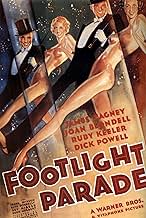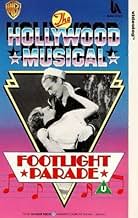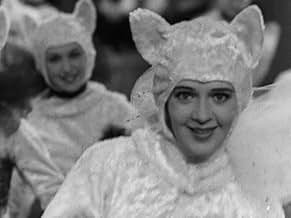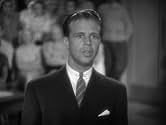Aggiungi una trama nella tua linguaChester Kent struggles against time, romance, and a rival's spy to produce spectacular live "prologues" for movie houses.Chester Kent struggles against time, romance, and a rival's spy to produce spectacular live "prologues" for movie houses.Chester Kent struggles against time, romance, and a rival's spy to produce spectacular live "prologues" for movie houses.
- Regia
- Sceneggiatura
- Star
- Premi
- 3 vittorie totali
- Chorus Girl
- (non citato nei titoli originali)
- Chorus Girl
- (non citato nei titoli originali)
Recensioni in evidenza
Sure, Warner Bros. tries to cover the orgy with the fig leaf of two cheerful innocents played by a sappy Dick Powell and a virginal Ruby Keeler. But it doesn't work, because everyone else gets in on the fun, including that human buzz-saw Jimmy Cagney and everyone's favorite sassy dame Joan Blondell. Director Lloyd Bacon proves too he knows what to do, giving us an eyeful of Blondell endlessly rolling and unrolling her hosiery, while the writers pepper the conversation with suggestive one-liners. Yeah, it's a great movie-- good enough to help bring down the heavy hand of censorship the following year, and put an end to damp dreams like "Beside a Waterfall". But not even the Watchdogs of Public Morality could stop Berkeley's deliriously suggestive pageantry that would live on at even that most repressed of studios, MGM. Sure, Astaire-Rogers may have been more graceful and a whole lot more chaste, no doubt producing more sheer polish-- still and all, don't let this unabashedly pagan celebration pass you by. As they say around the owl cage, it's a real hoot.
The first half of "Footlight Parade" is preparation for a musical extravaganza which occupies the last half of the film. Chester Kent (Cagney) is about to lose his job and does lose his playgirl wife as a result of talking pictures squeezing out live stage musicals. His producers take him to see a popular talky of the day, John Wayne in "The Big Trail." Before each showing of the flick, a dance number is presented as a prologue. Shorts, news reels, serials, and cartoons would later serve the purpose. Kent gets the idea that a prologue chain would be the road to salvation for the dwindling live musical business. Kent is basically an idea man along the lines of choreographer Busby Berkeley. Could it be that Cagney's character is patterned after Berkeley? Could be.
In preparation for the prologues, Kent learns that his ideas are being stolen by a rival. He uncovers the traitor, fires him, then unbeknown to him a new leak is planted in the form a dazzling temptress. His assistant, Nan Prescott (Joan Blondell - soon to be Mrs. Dick Powell) has the hots for Kent and is determined to expose the wiles of the temptress. A new singer from Arkansas College shows up in the form of Scotty Blain (Dick Powell) who turns out to be a real find and is paired with Bea Thorn (Ruby Keeler). The resulting three prologue musicals, which couldn't possibly have been presented on any cinema stage of the day, are as fresh and enjoyable today as they were over seventy years ago, "Honeymoon Hotel," "By a Waterfall," and "Shanghai Lil."
Of special note is the song and dance of tough-guy James Cagney. Like Fred Astaire and Bill "Bojangles" Robinson, Cagney's dancing appeared natural and unrehearsed, although hours went into practice to get each step just right. Not as good a singer as Astaire, Cagney's singing, like Astaire's, sounded natural, unlike the crooning so popular at the time. It's amazing that one person could be so talented and so versatile as James Cagney.
Most critics prefer the "Shanghai Lil" segment over the other two. Yet the kaleidoscopic choreography of "By a Waterfall" is astonishing. How Berkeley was able to film the underwater ballets and to create the human snake chain must have been difficult because it has never been repeated. The close up shots mixed brilliantly with distant angles is a must-see. The crisp black and white photography is much more artistic than it would have been if shot in color.
Though not nearly as socially conscious as "Gold Diggers of 1933," "Footlight Parade" stands on its own as one of the most amazing and outrageous musicals ever put on the big screen.
The realistic, satirical treatment gives a fresh edge to the material and its pace and line delivery are breathtaking. To think that they only started making feature talking pictures 7 years before this! The brilliance of the dialogue cannot be matched anywhere today, especially considering that "realism" has taken over and engulfed contemporary cinema.
This film was made at a time when the Hayes code restricting content was being ignored and the result is a fresh, self-referential, critical and living cinema that spoke directly to contemporary audiences suffering through the depression and the general angst of the age. I'd recommend watching any film from this period, that is 1930-1935, for a vision of what popular cinema can potentially be.
Cagney is even doing a bit of singing in this one and also quite an amount of dancing. And it needs to be said that he was not bad at it. He plays the role with a lot of confidence. He apparently had some dancing jobs in his early life before his acting career started to take off big time, so it actually isn't a weird thing that he also took on some musical acting roles in his career. He obviously also feels at ease in this totally different genre than most people are accustomed to seeing him in.
The movie is directed by Lloyd Bacon, who was perhaps among the best and most successful director within the genre. His earliest '30's musicals pretty much defined the musical genre and he also was responsible for genre movies such as "42nd Street". His musicals were always light and fun to watch and more comedy like than anything else really. '30's musicals never were really about its singing, this was something that more featured in '40's and later made musicals, mainly from the MGM studios.
As usual it has a light and simple story, set in the musical world, that of course is also predictable and progresses in a formulaic way. It nevertheless is a fun and simple story that also simply makes this an entertaining movies to watch. So do the characters and actors that are portraying them. Sort of weird though that that the total plot line of the movie gets sort of abandoned toward the end of the movie, when the movie only starts to consists out of musical number routines.
The musical moments toward the ending of the movie are also amusing and well done, even though I'm not a too big fan of the genre itself. Once again the musical numbers also feature a young Billy Barty. he often played little boys/babies/mice and whatever more early on in his career, including the movie musical "Gold Diggers of 1933", of one year earlier.
A recommendable early genre movie.
8/10
http://bobafett1138.blogspot.com/
Watching it again tonight, I was, however, struck yet once again by the genius of Busby Berkeley in staging the last three numbers, the "prologues." Most remarkable of a very remarkable trio for me is "Beside a waterfall." It just keeps building and building and building. Yes, of course, some of the shots of the women in the water are very erotic. It was 1933, after all, and before the Hayes Code. Berkeley and Warner Brothers understood that pretty women posed erotically had a real appeal to men,
------------------------------------
I watched the end of this movie again this morning. Perhaps I paid closer attention to this number this time, perhaps I was just in the right "mood." Either way, I marveled at the suggestiveness of so much of it. Those jets of water spurting up - I use the verb advisedly - between the swimming women's legs. All those shots of women opening and closing their legs. It was remarkably erotic on my 46" tv screen. What must it have been like in 1933 on huge movie theater screens in the era before multiplexes????
==========================================
But these erotic poses are not JUST erotic poses. The number keeps building and building and building. What will he do next, you keep wondering? Oh, that. But "that" is even more incredible than what has come before. By the time you get to the end of this number, you're exhausted, not just physically and erotically, but imaginatively as well. How could anyone have maintained and built on that suspense for 10 whole minutes? I can't tell you, but Berkeley did.
Third of the three prologues, "Shanghai Lil," is definitely not something that could have been filmed the same way just a year or two later when the Production Code was put in force. We see an opium den, a lot of prostitutes, at least one interracial couple, etc.
Having watched it again tonight, I will add that this is a strange "musical." There is almost no music for the first hour and a half. It's all in the three closing numbers. But what numbers!
Lo sapevi?
- QuizFirst film where James Cagney dances - showing off his vaudeville and stage experience as a song-and-dance man. Cagney lobbied Warner Bros. to play this role. He would show off these talents to their fullest in Ribalta di gloria (1942).
- BlooperAfter the "By A Waterfall" prologue ends, the film cuts to the audience giving an animated and thunderous applause, but in the balcony there is no applause or reaction. In fact, there is no movement whatsoever. They are perfectly still which indicates that a photo or painting was used for the balcony audience and then merged with the live theatre audience. The same photo/painting was also used for the "Shanghai Lil" balcony audience.
- Citazioni
Nan Prescott: You scram, before I wrap a chair around your neck!
Vivian Rich: [Angrily] It's three o'clock in the morning - where do you want me to go?
[Nan starts to speak, but Vivian immediately cuts her off]
Vivian Rich: You cheap stenographer...
Nan Prescott: Outside, countess. As long as they've got sidewalks YOU'VE got a job.
[Shoves her out, gives her a swift kick in the rump, and slams the door behind her]
- Versioni alternativeThere is an Italian edition of this film on DVD, distributed by DNA srl, "VIVA LE DONNE! (1933) + AMORE IN OTTO LEZIONI (1936)" (2 Films on a single DVD), re-edited with the contribution of film historian Riccardo Cusin. This version is also available for streaming on some platforms.
- ConnessioniEdited into Busby Berkeley and the Gold Diggers (1969)
- Colonne sonoreA Vision of Salome
(1908) (uncredited)
Music by J. Bodewalt Lampe
Played during the prologue scene in the movie theater
I più visti
Dettagli
- Data di uscita
- Paese di origine
- Lingue
- Celebre anche come
- Las deliciosas
- Luoghi delle riprese
- Azienda produttrice
- Vedi altri crediti dell’azienda su IMDbPro
Botteghino
- Budget
- 703.000 USD (previsto)
- Lordo in tutto il mondo
- 276 USD
- Tempo di esecuzione1 ora 44 minuti
- Colore
- Proporzioni
- 1.37 : 1
Contribuisci a questa pagina









































